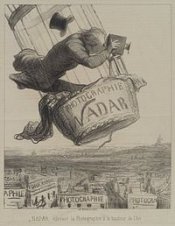Marco B
Subscriber
Hi all,
Some time ago, I read some chapters of a nice exhibition catalogue of a 1994 exhibition about Nadar in the Musée d'Orsay in Paris.
Now I didn't know much about Nadar, except being a well established photographer running a large photo studio in Paris in the early days of photography half way the 19th century, and I thus always assumed he was some kind of successful, possibly gentleman, well-of photographer in his time.
Now the biography included in that catalogue, opened my eyes to an entirely different personality. A kind of energetic 19th century "Andy Warhol", breaking a lot of social rules and living as a Dandy, but often broke, despite his undisputed successes and crazy projects like his balloon ride over Paris carrying his LF camera to take the first aerial pictures ever.
To give you just some perspective, here are two quotes of the catalogue I wrote down in my notebook to remember, and that I loved reading:
"His frequent disappearances and successive addresses suggest that like Fauchery, his fellow contributor to 'Le corsaire-satan', he knew the Bohemian Code: 1) Rent should never be paid. 2) All moves are made through the window. 3) Tailors, boot makers, hatters, and restaurateurs are relatives of 'Monsieur Crédit'.
Whether or not Nadar practiced these tactics, his creditors finally caught him. The days spent in debtor's prison in 1850 provided the substance for his fascinating description of insanity produced by incarceration."
"His capacity to enjoy whatever he could and to the utmost, despite the real problems of existence, is deliciously illustrated by the recollection of fellow caricaturist and photographer Étienne Carjat, as reported by the Goncourt brothers: '[Nadar] lived with a woman for two months without going out, in bed, with no clothes to wear. The woman had pantaloons and yellow leather boots, in which she went to the opera ball. They had a passion for oysters, and oyster shells piled up all over the room, finally carpeting the floor'"
I loved these images and quotes. Despite being anecdotal, Nadar's live really seems to have been a whirlpool, or should I say "tornado", of interesting events...

Marco
Some time ago, I read some chapters of a nice exhibition catalogue of a 1994 exhibition about Nadar in the Musée d'Orsay in Paris.
Now I didn't know much about Nadar, except being a well established photographer running a large photo studio in Paris in the early days of photography half way the 19th century, and I thus always assumed he was some kind of successful, possibly gentleman, well-of photographer in his time.
Now the biography included in that catalogue, opened my eyes to an entirely different personality. A kind of energetic 19th century "Andy Warhol", breaking a lot of social rules and living as a Dandy, but often broke, despite his undisputed successes and crazy projects like his balloon ride over Paris carrying his LF camera to take the first aerial pictures ever.
To give you just some perspective, here are two quotes of the catalogue I wrote down in my notebook to remember, and that I loved reading:
"His frequent disappearances and successive addresses suggest that like Fauchery, his fellow contributor to 'Le corsaire-satan', he knew the Bohemian Code: 1) Rent should never be paid. 2) All moves are made through the window. 3) Tailors, boot makers, hatters, and restaurateurs are relatives of 'Monsieur Crédit'.
Whether or not Nadar practiced these tactics, his creditors finally caught him. The days spent in debtor's prison in 1850 provided the substance for his fascinating description of insanity produced by incarceration."
"His capacity to enjoy whatever he could and to the utmost, despite the real problems of existence, is deliciously illustrated by the recollection of fellow caricaturist and photographer Étienne Carjat, as reported by the Goncourt brothers: '[Nadar] lived with a woman for two months without going out, in bed, with no clothes to wear. The woman had pantaloons and yellow leather boots, in which she went to the opera ball. They had a passion for oysters, and oyster shells piled up all over the room, finally carpeting the floor'"
I loved these images and quotes. Despite being anecdotal, Nadar's live really seems to have been a whirlpool, or should I say "tornado", of interesting events...

Marco
Last edited by a moderator:







